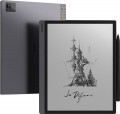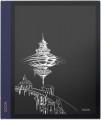E-book formats
File formats supported by the reader that contain text (and sometimes graphic information). The most popular in the CIS are, in particular,
FB2,
TXT,
HTML,
WORD (DOC),
RTF,
ePUB,
Djvu and
PDF.
Photo/video formats
File formats supported by the reader that contain multimedia information — graphics or video. The most popular image file formats are, among others,
JPG(the standard format for modern digital photography), BMP and GIF; video files —
MP4, MPG,
AVI, 3GP (video format for mobile devices),
FLV, MOV.
Storage capacity
The amount of the reader's own built-in memory, i.e. the memory used for persistent data storage. The more memory, the more content can be stored at a time in the e-book. At the same time, note that even the largest text (TXT, FB2, HTML) files, usually, rarely exceed 2 – 3 MB, so relatively little memory is needed for storage. Graphic and audio files, in turn, are more voluminous, but most of the space is needed for video files. Therefore, depending on the use of the gadget, you will need a different volume, whether it be
4 GB, 8 GB or more. Many readers support the ability to expand their own memory through removable cards (see
Memory card slot).
Card reader
Possibility of expansion of own built-in memory at the expense of replaceable memory cards. In addition to increasing the amount of memory, such a medium facilitates the exchange of information between an e-book and other devices: for example, you can download a book to a laptop equipped with a card reader, write it to a memory card and install the card in an e-book. Note that at the present time several types of memory cards are actively used, and not all of them are mutually compatible; therefore, when buying a book with a memory card slot, you need to pay special attention to the type of cards supported.
Multimedia
—
Headphone output(3.5 mm). A standard mini-jack connector that allows you to connect headphones to an audiobook. Most consumer-grade headphones currently being produced are equipped with a 3.5 mm plug, which makes this connector very versatile. Usually, the presence of a headphone output in an audiobook means that it is equipped with a built-in media player, and headphones can also be used to read text from the screen.
—
Dictaphone. The ability to use an e-book as a voice recorder, to record speech and other sounds. To do this, the device is equipped with its own built-in microphone, and to play the recorded material, an output to headphones and/or its own speaker is provided.
—
Built-in speaker. The audiobook has its own built-in speaker. The speaker can be used to play audio files, video soundtrack, or read text from the screen; the presence of a speaker, usually, implies the presence in the reader of at least one of the above functions.
—
Built-in dictionary. The presence in the software set of the book of an electronic dictionary (or several dictionaries), which allows the translation of individual words and expressions. This feature can be especially useful for those who like to read books in foreign languages.
— Built-in browser. The presence of a built-in browser allows you to view Internet
...pages on the screen of the reader; connection to the Internet is carried out using Wi-Fi.
— Built-in audio player. The ability to use an e-book to play audio files through headphones or a built-in speaker. The most common support for MP3 music files; some models are capable of playing other types of audio files, such as WMA, AAC, OGG, and even the lossless APE and FLAC formats.
— Voice reading. The ability of an e-book to read the written text and output it to external speakers or connected headphones. The voice sounds quite monotonous and with a noticeable "computer" accent. Pronunciation, usually, is at a level sufficient for understanding.
— Accelerometer. A device that reacts to shaking and changes in the position of an e-book in space. The accelerometer provides advanced control options: for example, you can change the screen orientation from portrait to landscape and vice versa by simply turning the reader to the appropriate position, switch the music track by shaking, etc.Case included
The presence
of a case in the delivery set of the electronic reader.
The case facilitates transportation of the device, protects its body from dirt and scratches, and to some extent protects from impacts and vibrations. The design of such an accessory can be different. One of the popular implementations is the "book" format (the case opens in the image and likeness of a book cover), cases exclusively for the back panel of the e-reader are also often found.
Material
The main material used for the body of an e-book.
—
Plastic. Plastic enclosures are inexpensive, light in weight, and provide enough strength for everyday use. It is also worth noting that there are many grades of this material, and the quality of the plastic used for the body usually directly depends on the price category of the book. Of the unequivocal disadvantages of this option, low scratch resistance can be called; in addition, if the plastic is glossy, prints and stains instantly appear on it.
—
Metal. Most often in cases, metal refers to aluminium alloy. One of the key advantages of this material is durability. In addition, the metal resists scratches very well and gives the device solidity — both in appearance and in the feel in the hands. It weighs a little more than plastic, but often it is this moment that provides the mentioned solidity. The unequivocal disadvantage of metal cases is a rather high cost.
—
Magnesium Alloy. Such alloys are superior in strength to metal, while they have a relatively small weight and excellent heat dissipation. However, this material is not cheap. Therefore, it is used quite rarely and mainly in combination with other, usually more accessible materials.

